Rock-Forming (Biotite and Plagioclase) and Accessory (Zircon) Minerals Geochemistry as an Indicator of the Metal Fertility of Magmas by the Example of Au-Cu-Fe-Skarn Deposits in Eastern Transbaikalia
Abstract
:1. Introduction
2. Geological Setting
2.1. The Lugokan Deposit
2.2. The Kultuma Deposit
2.3. The Bystrinsky Deposit
3. Analytical Methods
4. Results
4.1. Plagioclase Chemistry
4.2. Biotite Chemistry
4.3. Zircon Geochemistry
4.3.1. The Lugokan Deposit
4.3.2. The Kultuma Deposit
4.3.3. The Bystrinsky Deposit
5. Discussion
5.1. Plagioclase Mineral Geochemistry as an Indicator for Magmatic Fertility
5.2. Biotite Mineral Geochemistry
5.3. Zircon Mineral Geochemistry as an Indicator for Magmatic Fertility
5.4. Mineral Geothermobarometer
6. Conclusions
- Investigation of zircon geochemistry showed that the best parameters for the prediction of the fertile magmatic rocks are Ce/Ce*, Eu/Eu*, Yb/Dy, (Ce/Nd)/Y. An increase in the values of Ce/Ce* Eu/Eu*, Yb/Dy, (Ce/Nd)/Y from the Lugokan deposit to the Kultuma and Bystrinsky deposits coincides with the resources of these three deposits increasing. The most fertile magmatic rocks at the Bystrinsky deposit are porphyry rocks of the Shakhtama complex second phase (159.6–158.6 Ma), which are composed of monzonite- and diorite-porphyries. The magmatic rocks characterized by the high ore-bearing potential for the classical porphyry type of mineralization in Eastern Transbaikalia have Ce/Ce* > 100, Eu/Eu* > 0.4, Yb/Dy > 5.0 and (Ce/Nd)/Y > 0.01 values.
- Estimation of the magmatic rock fertility based on plagioclase chemistry also demonstrated that the highest ore-bearing potential for the porphyry type is inherent of the magmatic rocks that occurred at the Bystrinsky deposit. The extent of potential ore content may be assessed relying on the number of points on the analysis data in the An%−Al/(Ca + Na + K) diagram fitting in the fertile area. Al* in combination with data on the chemical composition of biotite and zircon is the most effective.
- The halogen composition of biotite may be evidence of the ore-bearing potential (fertility) of magmatic rocks. The used parameters IV(F), IV(F/Cl), X(F)/X(OH) allows us to establish the criteria for the Au-Cu-Fe-skarn systems of Eastern Transbaikalia. The Bystrinsky deposit, with the highest ore resources among the studied deposits, is characterized by the values: IV (F) > 2.2, IV (F/Cl) > 6.5, X (F)/X (OH) < −1.2, while lower IV(F) and IV(F/Cl) values along with higher X(F)/X(OH) ratios are typical for the Kultuma and Lugokan deposits. It may be stated that magmatic rocks with biotite distinguished by higher IV(F) and IV(F/Cl) values along with lower X(F)/X(OH) ratios may be ore-bearing for the porphyry type.
Supplementary Materials
Author Contributions
Funding
Data Availability Statement
Conflicts of Interest
References
- Spiridonov, A.M.; Zorina, L.D.; Kitaev, N.A. Gold-Bearing Ore-Magmatic Systems of Transbaikalia; GEO Academic Publishing House: Novosibirsk, Russia, 2006; 291p. (In Russian) [Google Scholar]
- Nornickel. Available online: https://www.nornickel.ru/investors/disclosure/annual-reports/#2008 (accessed on 28 December 2021).
- Belousova, E.; Griffin, W.L.; O’Reilly, S.Y.; Fisher, N.L. Igneous zircon: Trace element composition as an indicator of source rock type. Contrib. Mineral. Petrol. 2002, 143, 602–622. [Google Scholar] [CrossRef]
- Shen, P.; Hattori, K.; Pan, H.; Jackson, S.; Seitmuratova, E. Oxidation condition and metal fertility of granitic magmas: Zircon trace-element data from porphyry Cu deposits in the central Asian orogenic belt. Econ. Geol. 2015, 110, 1861–1878. [Google Scholar] [CrossRef]
- Lu, Y.J.; Loucks, R.R.; Fiorentini, M.; McCuaig, T.C.; Evans, N.J.; Yang, Z.M.; Hou, Z.Q.; Kirkland, C.L.; Parra-Avila, L.A.; Kobussen, A. Zircon compositions as a pathfinder for porphyry Cu ± Mo ± Au deposits. Soc. Econ. Geol. Spec. Publ. 2016, 19, 329–347. [Google Scholar]
- Wen, G.; Zhou, R.-J.; Li, J.-W.; Chang, J.; Hu, H.; Yan, D.-R.; Wei, K.-T.; Jin, S.-G. Skarn metallogeny through zircon record: An example from the Daye Cu-Au-Fe-Mo district, eastern China. Lithos 2020, 378–379, 105807. [Google Scholar] [CrossRef]
- Williamson, B.J.; Herrington, R.J.; Morris, A. Porphyry copper enrichment linked to excess aluminum in plagioclase. Nature Geosci. 2016, 9, 237–241. [Google Scholar] [CrossRef] [Green Version]
- Williamson, B.J.; Hodgkinson, M.; Imai, A.; Takahasgi, R.; Armstrong, R.N.; Herrington, R.J. Testing the plagioclase discriminator on the GEOROC database to identify porphyry-fertile magmatic systems in Japan. Resour. Geol. 2018, 68, 138–143. [Google Scholar] [CrossRef] [Green Version]
- Selby, D.; Nesbitt, B.E. Chemical composition of biotite from the Casino porphyry Cu-Au-Mo mineralization, Yukon, Canada: Evaluation of magmatic and hydrothermal fluid chemistry. Chem. Geol. 2000, 171, 77–93. [Google Scholar] [CrossRef]
- Azadbakht, Z.; Lentz, D.R.; McFarlane, C.R.M.; Whalen, J.B. Using magmatic biotite chemistry to differentiate barren and mineralized Silurian–Devonian granitoids of New Brunswick, Canada. Contrib. Mineral. Petrol. 2020, 175, 1–24. [Google Scholar] [CrossRef]
- Berzina, A.P.; Berzina, A.N.; Gimon, V.O.; Nikolaeva, I.V.; Krymskiy, R.S.; Larionov, A.N.; Serov, P.A. The Shakhtama porphyry Mo ore-magmatic system (Eastern Transbaikalia): Age, sources and genetic features. Russ. Geol. Geophys. 2013, 54, 587–605. [Google Scholar] [CrossRef]
- Redin, Y.O.; Redina, A.A.; Mokrushnikov, V.P.; Dultsev, V.F. Antinsky ore occurrence as an example of ore-forming systems related to reduced intrusions (Eastern Transbaikalia). Bull. Tomsk Polyt. Univ. Geo Ass. Engin. 2018, 329, 17–29, (in Russian with English abstract). [Google Scholar]
- Redin, Y.O.; Mokrushnikov, V.P.; Redina, A.A.; Nevolko, P.A.; Kolpakov, V.V. Gold-Copper-Iron-Skarn Deposits of East Transbaikalia: Types, Mineral Composition, Age and Formation Conditions. In Ore-Magmatic Systems. Magmatizm, Metallogeny, and Tectonics of North Asia; IGM SB RAS: Novosibirsk, Russia, 2018; pp. 83–90. (In Russian) [Google Scholar]
- Redin, Y.O.; Redina, A.A.; Prokopiev, I.R.; Dultsev, V.F.; Kirillov, M.V.; Mokrushnikov, V.P. The Lugokanskoe Au-Cu skarn deposit (Eastern Transbaikalia): Mineral composition, age, and formation conditions. Russ. Geol. Geophys. 2020, 61, 174–195. [Google Scholar] [CrossRef]
- Zorin, Y.A.; Belinchenko, V.G.; Rutshtein, I.G.; Zorina, L.D.; Spiridonov, A.M. Geodynamics of the western part of the Mongol–Okhotsk belt and tectonic position of gold occurrence in Transbaikalia. Russ. Geol. Geophys. 1998, 39, 1578–1586. [Google Scholar]
- Zorin, Y.A.; Zorina, L.D.; Spiridonov, A.M.; Rutshtein, I.G. Geodynamic setting of gold deposits in the Transbaikal region (Eastern Siberia, Russia). Ore Geol. Rev. 2001, 17, 215–232. [Google Scholar] [CrossRef]
- Kovalenker, V.A.; Abramov, S.S.; Kiseleva, G.D.; Krylova, T.L.; Yazykova, Y.I.; Bortnikov, N.S. The large Bystrinskoe Cu-Au-Fe deposit (Eastern Trans-Baikal Region): Russia’s first example of a skarn-porphyry ore-forming system related to adakite. Dokl. Earth Sci. 2016, 468, 566–570. [Google Scholar] [CrossRef]
- Kovalenker, V.A.; Trubkin, N.V.; Abramova, V.D.; Plotinskaya, O.Y.; Kiseleva, G.D.; Borisovskii, S.E.; Yazykova, Y.I. Typomorphic characteristics of molybdenite from the Bystrinsky Cu-Au porphyry-skarn deposit, Eastern Transbaikal region, Russia. Geol. Ore Depos. 2018, 60, 62–81. [Google Scholar] [CrossRef]
- Zhang, C.; Holtz, C.; Ma, C.Q.; Wolff, P.E.; Li, X.Y. Tracing the evolution and distribution of F and Cl in plutonic systems from volatile-bearing minerals: A case study from the Liujiawa pluton (Dabie orogeny, China). Contrib. Mineral. Petrol. 2012, 164, 859–879. [Google Scholar] [CrossRef]
- Nachit, H.; Ibhi, A.; Abia, E.H.; Ohoud, M.B. Discrimination between primary magmatic biotites, reequilibrated biotites and neoformed biotites. C. R. Geosci. 2005, 337, 1415–1420. [Google Scholar] [CrossRef]
- Abdel-Rahman, A.F.M. Nature of biotites from alkaline, calc-alkaline, and peraluminous magmas. J. Petrol. 1994, 35, 525–541. [Google Scholar] [CrossRef]
- Ballard, J.R.; Palin, M.J.; Campbel, L.H. Relative oxidation states of magmas inferred from Ce(IV)/Ce(III) in zircon: Application to porphyry copper deposits of northern Chile. Contrib. Mineral. Petrol. 2002, 144, 347–364. [Google Scholar] [CrossRef]
- Gardiner, N.J.; Hawkesworth, C.J.; Robb, L.J.; Whitehouse, M.J.; Roberts, N.M.W.; Kirkland, C.L.; Evans, N.J.; Naturhistoriska, R.; Enheten, F.G. Contrasting granite metallogeny through the zircon record: A case study from Myanmar. Sci. Rep. 2017, 7, 748–749. [Google Scholar] [CrossRef] [Green Version]
- Jin, X.Y.; Li, J.W.; Hofstra, A.H.; Sui, J.X. Magmatic-hydrothermal origin of the early Triassic Laodou lode gold deposit in the Xiahe-Herzuo district, West Qinling orogen, China: Implications for gold metallogeny. Mineral. Depos. 2017, 52, 883–902. [Google Scholar] [CrossRef]
- Lee, R.G.; Dilles, J.H.; Tosdal, R.M.; Wooden, J.L.; Mazdab, F.K. Magmatic evolution of granodiorite intrusions at the el Salvador porphyry copper deposit, Chile, based on trace element composition and U/Pb age of zircons. Econ. Geol. 2017, 112, 245–273. [Google Scholar] [CrossRef]
- Shu, Q.H.; Chang, Z.S.; Lai, Y.; Hu, X.; Wu, H.Y.; Zhang, Y.; Wang, P.; Zhai, D.G.; Zhang, C. Zircon trace elements and magma fertility: Insights from porphyry (-skarn) Mo deposits in NE China. Mineral. Depos. 2019, 54, 645–656. [Google Scholar] [CrossRef]
- Zhong, S.; Feng, C.; Seltmann, R.; Li, D.; Dai, Z. Geochemical contrasts between Late Triassic ore-bearing and barren intrusions in the Weibao Cu-Pb-Zn deposit, East Kunlun Mountains, NW China: Constraints from accessory minerals (zircon and apatite). Mineral. Depos. 2018, 53, 855–870. [Google Scholar] [CrossRef] [Green Version]
- McDonough, W.F.; Sun, S.S. The composition of the Earth. Chem. Geol. 1995, 120, 223–253. [Google Scholar] [CrossRef]
- Hoskin, P.W.O.; Schaltegger, U. The composition of Zircon and Igneous and Metamorphic Petrogenessis. Rev. Miner. Geochem. 2003, 53, 27–62. [Google Scholar] [CrossRef]
- Zhong, S.; Seltmann, R.; Qu, H.; Song, Y. Characterization of the zircon Ce anomaly for estimation of oxidation state of magmas: A revised Ce/Ce* method. Mineral. Petrol. 2019, 113, 755–763. [Google Scholar] [CrossRef] [Green Version]
- Watson, E.B.; Wark, D.A.; Thomas, J.B. Crystallization thermometers for zircon and rutile. Contrib. Miner. Petrol. 2006, 151, 413–433. [Google Scholar] [CrossRef]
- Grabezkev, A.I.; Vigorova, V.G.; Chanshukina, V.A. Behavior of fluorine during crystallization of granites (in connection with validation of the criteria of granite specialization). Geochem. Int. 1979, 16, 22–33. [Google Scholar]
- Speer, J.A. Micas in igneous rocks. Rev. Mineral. 1984, 13, 299–356. [Google Scholar]
- Zhang, W.; Lentz, D.R.; Thorne, K.G.; McFarlane, C. Geochemical characteristics of biotite from felsic intrusive rocks around the Sisson Brook W-Mo-Cu deposit, west-central New Brunswick: An indicator halogen and oxygen fugacity of magmatic systems. Ore Geol. Rev. 2016, 77, 82–96. [Google Scholar] [CrossRef] [Green Version]
- Munoz, J.L. F-OH and Cl-OH exchange in micas with applications to hydrothermal ore deposits. Rev. Mineral. Geochem. 1984, 13, 469–493. [Google Scholar]
- Ague, J.J.; Brimhall, G.H. Regional variations in bulk chemistry, mineralogy, and the compositions of mafic and accessory minerals in the batholiths of California. Geol. Soc. Am. Bull. 1988, 100, 891–911. [Google Scholar] [CrossRef]
- Ague, J.J.; Brimhall, G.H. Magmatic arc asymmetry and distribution of anomalous plutonic belts in the batholiths of California: Effects of assimilation, crustal thickness, and depth of crystallization. Geol. Soc. Am. Bull. 1988, 100, 912–927. [Google Scholar] [CrossRef]
- Salet, R. Fluorine as a tool in the petrogenesis of quartz-bearing magmatic associations of an improved F-OH biotite-apatite thermometer gird. Lithos 2000, 50, 241–253. [Google Scholar] [CrossRef]
- Burnham, A.D.; Berry, A.J. An experimental study of trace element partitioning between zircon and melt as a function of oxygen fugacity. Geochim. Cosmochim. Acta 2012, 95, 196–212. [Google Scholar] [CrossRef]
- Trail, D.; Bruce Watson, E.; Tailby, N.D. Ce and Eu anomalies in zircon as proxies for the oxidation state of magmas. Geochim. Cosmochim. Acta 2012, 97, 70–87. [Google Scholar] [CrossRef]
- Dilles, J.H.; Kent, A.J.R.; Wooden, J.L.; Tosdal, R.M.; Koleszar, A.; Lee, R.G.; Farmer, L.P. Zircon compositional evidence for sulfur-degassing from ore-forming arc magmas. Econ. Geol. 2015, 110, 241–251. [Google Scholar] [CrossRef]
- Pizarro, H.; Campos, E.; Bouzari, F.; Rousse, S.; Bissig, T.; Gregoire, M.; Riquelme, R. Porphyry indicator zircons (PIZs): Application to exploration of porphyry copper deposits. Ore Geol. Rev. 2020, 126, 103771. [Google Scholar] [CrossRef]
- Munoz, M.; Charrier, R.; Fanning, C.M.; Maksaev, V.; Deckart, K. Zircon trace element and O-Hf isotope analyses of mineralized intrusion from EL Teniente ore deposit, Chilean Andes: Constraints on the source and magmatic evolution of porphyry Cu-Mo related magmas. J. Petrol. 2012, 53, 1091–1122. [Google Scholar] [CrossRef] [Green Version]
- Henry, D.J.; Guidotti, C.V.; Thomson, J.A. The Ti-saturation surface for low-to-medium pressure metapelitic biotites: Implications for geothermometry and Ti-substitution mechanisms. Am. Min. 2005, 90, 316–328. [Google Scholar] [CrossRef]
- Rezaei, M.; Zarasvandi, A. Titanium-in-biotite thermometry in porphyry copper systems: Challenges to application of the thermometer. Resour. Geol. 2019, 70, 1–12. [Google Scholar] [CrossRef]
- Uchida, E.; Endo, S.; Makino, M. Relationship between solidification depth of granitic rocks and formation of hydrothermal ore deposits. Resour. Geol. 2007, 57, 47–56. [Google Scholar] [CrossRef]
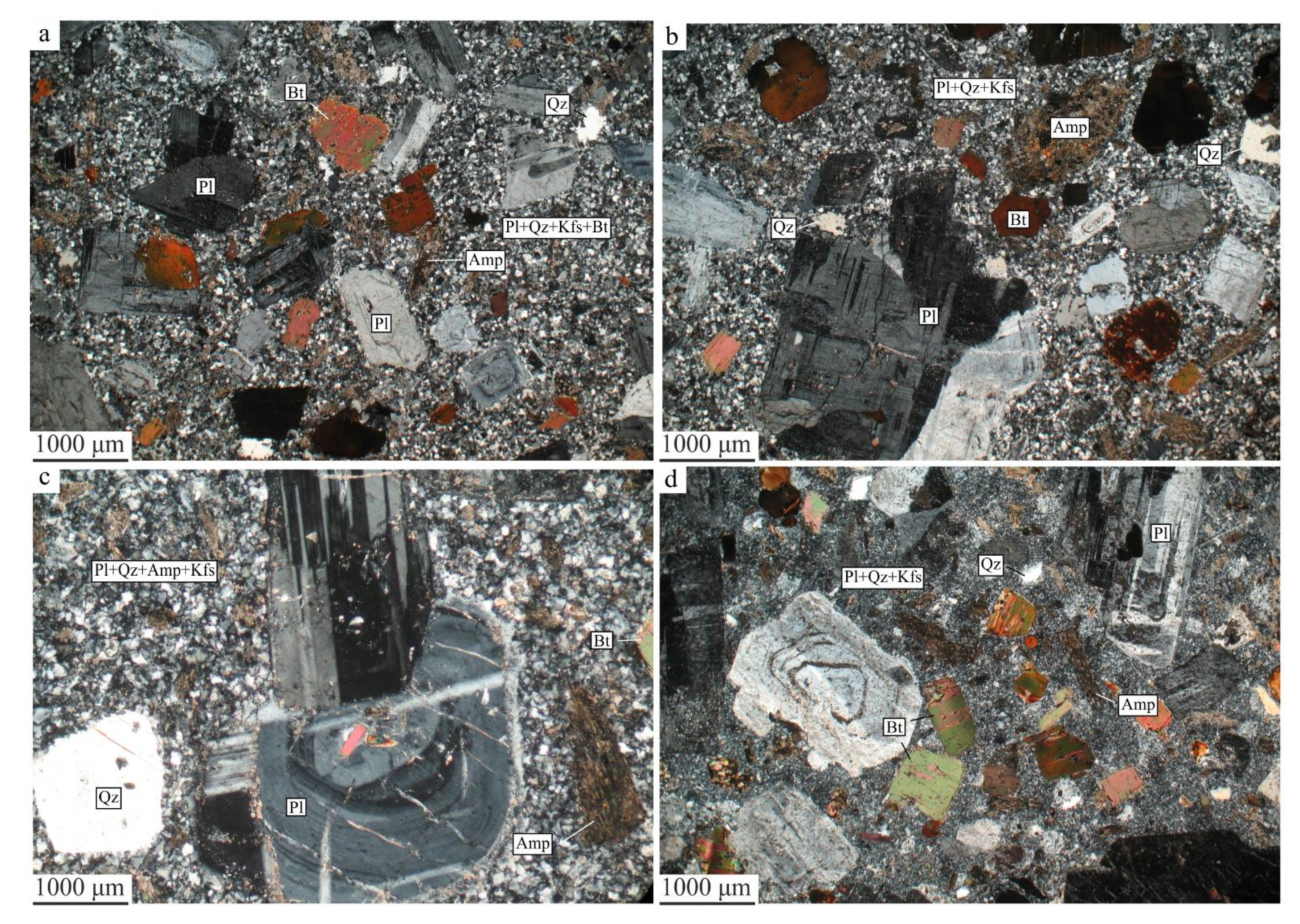
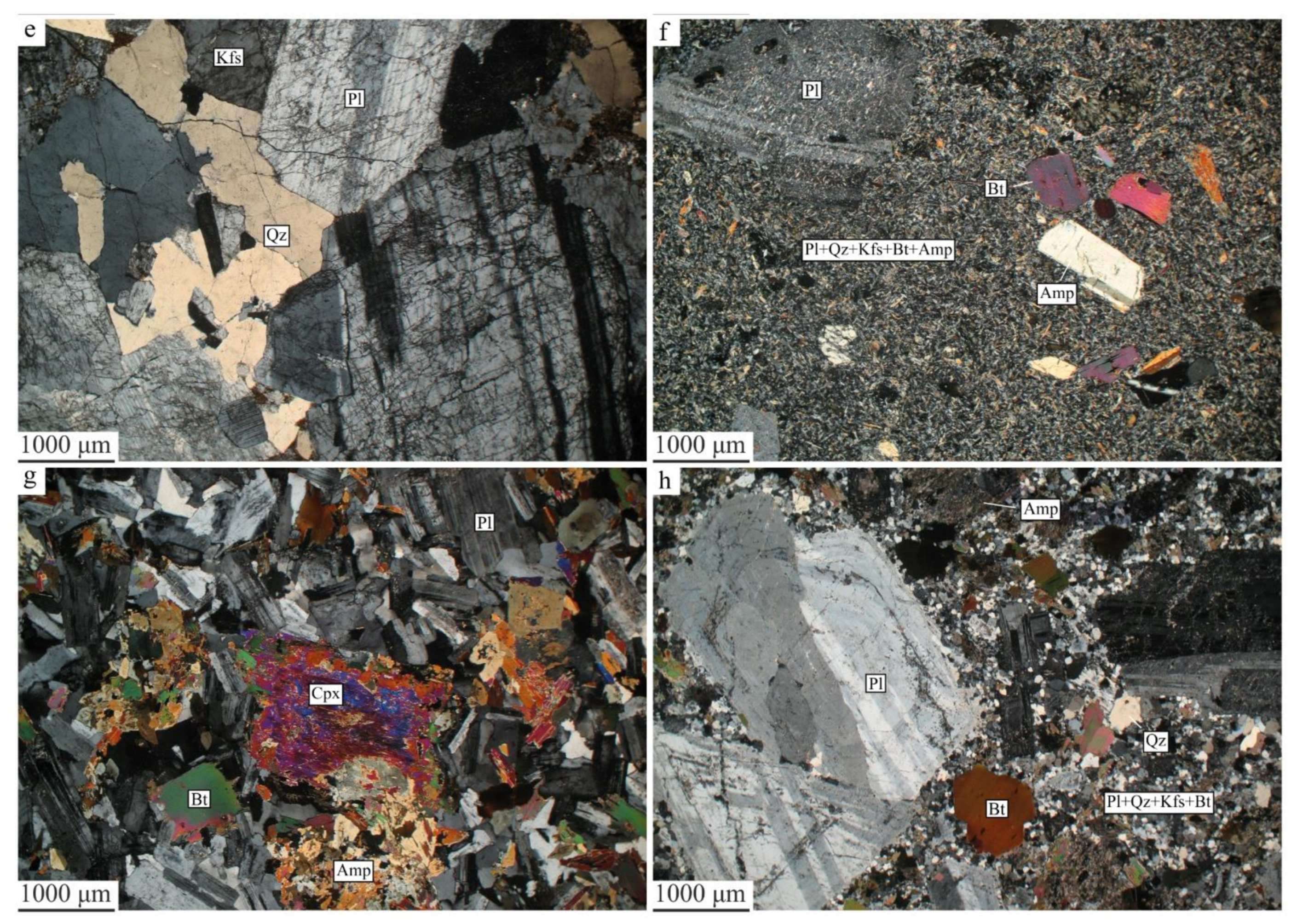
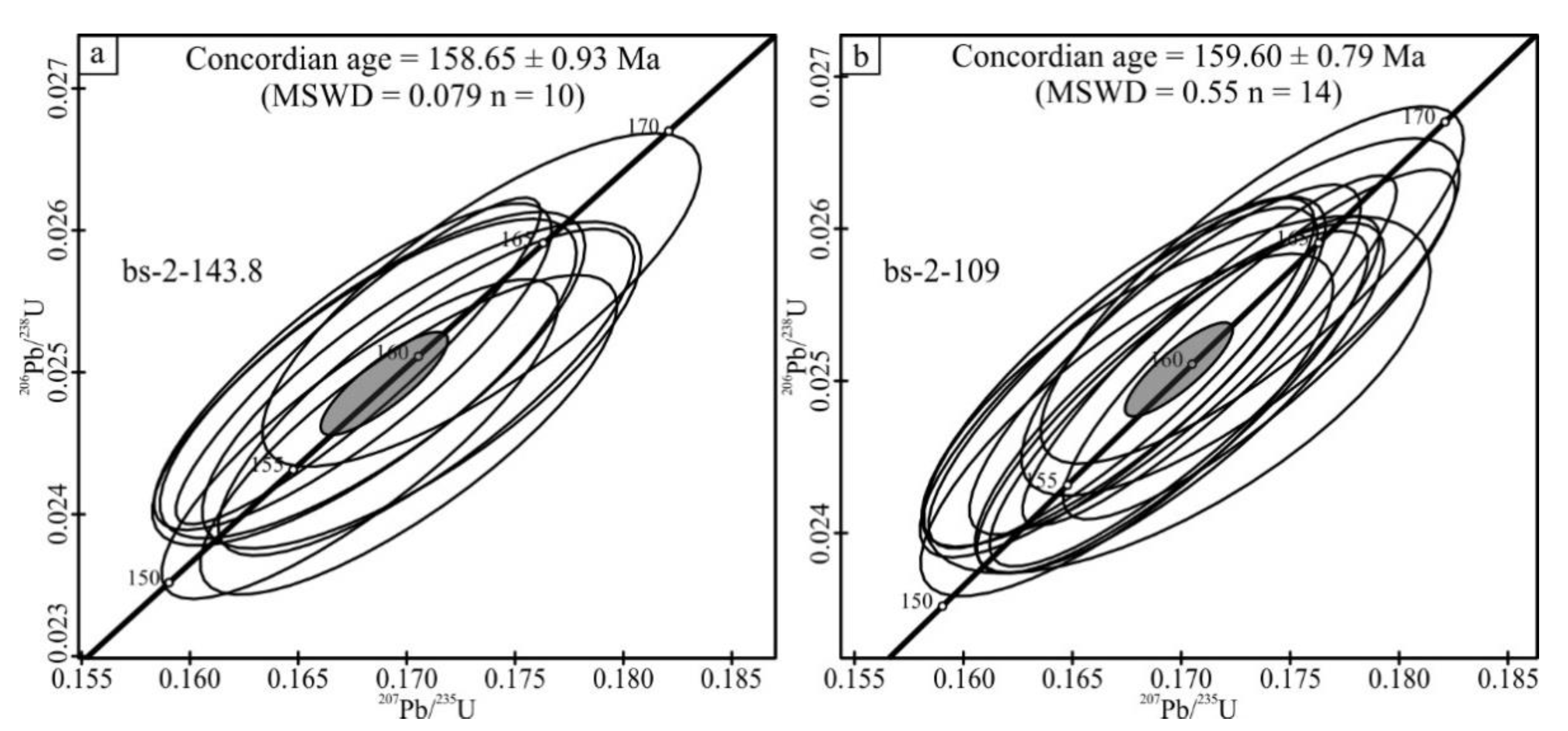
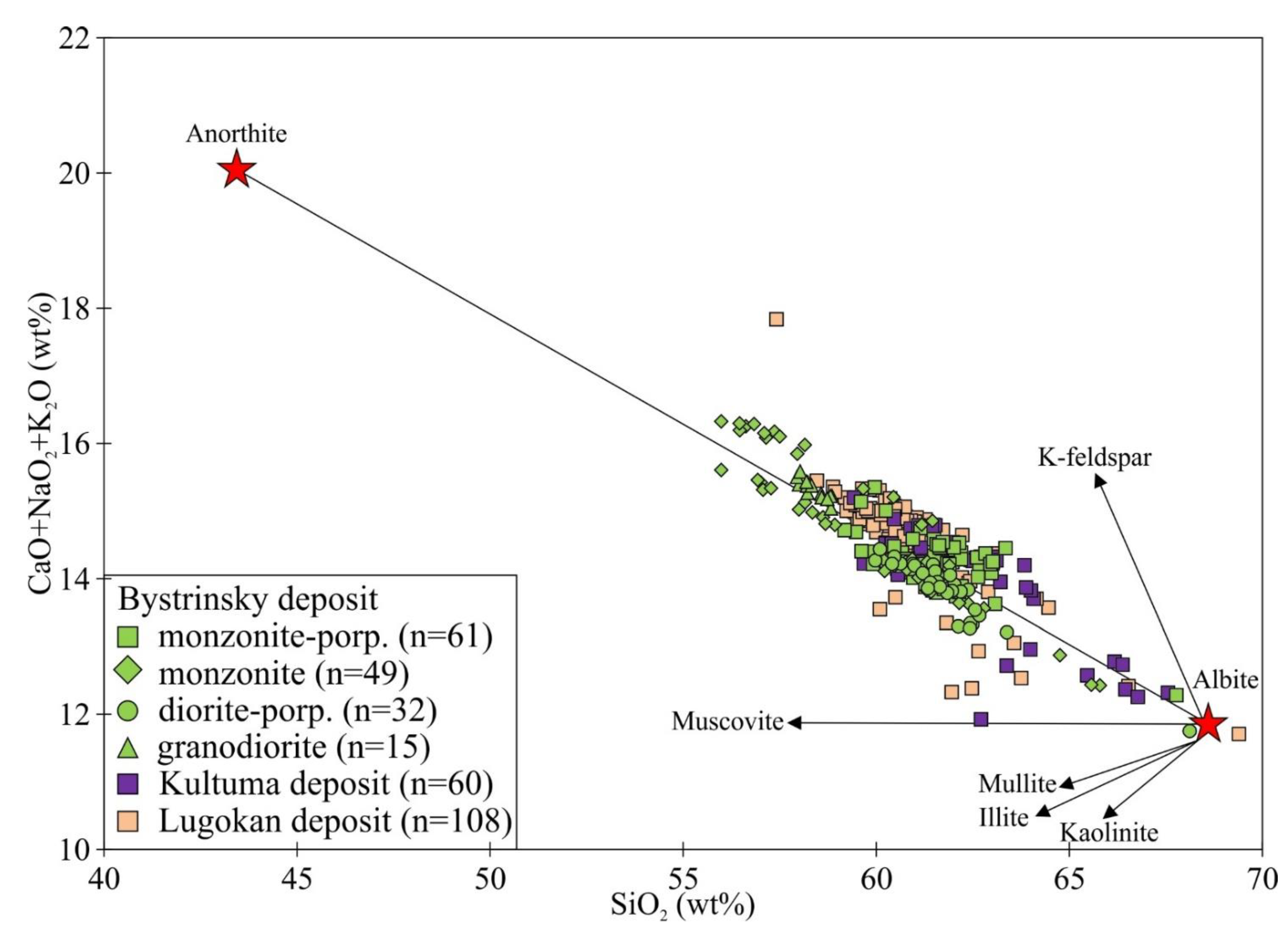
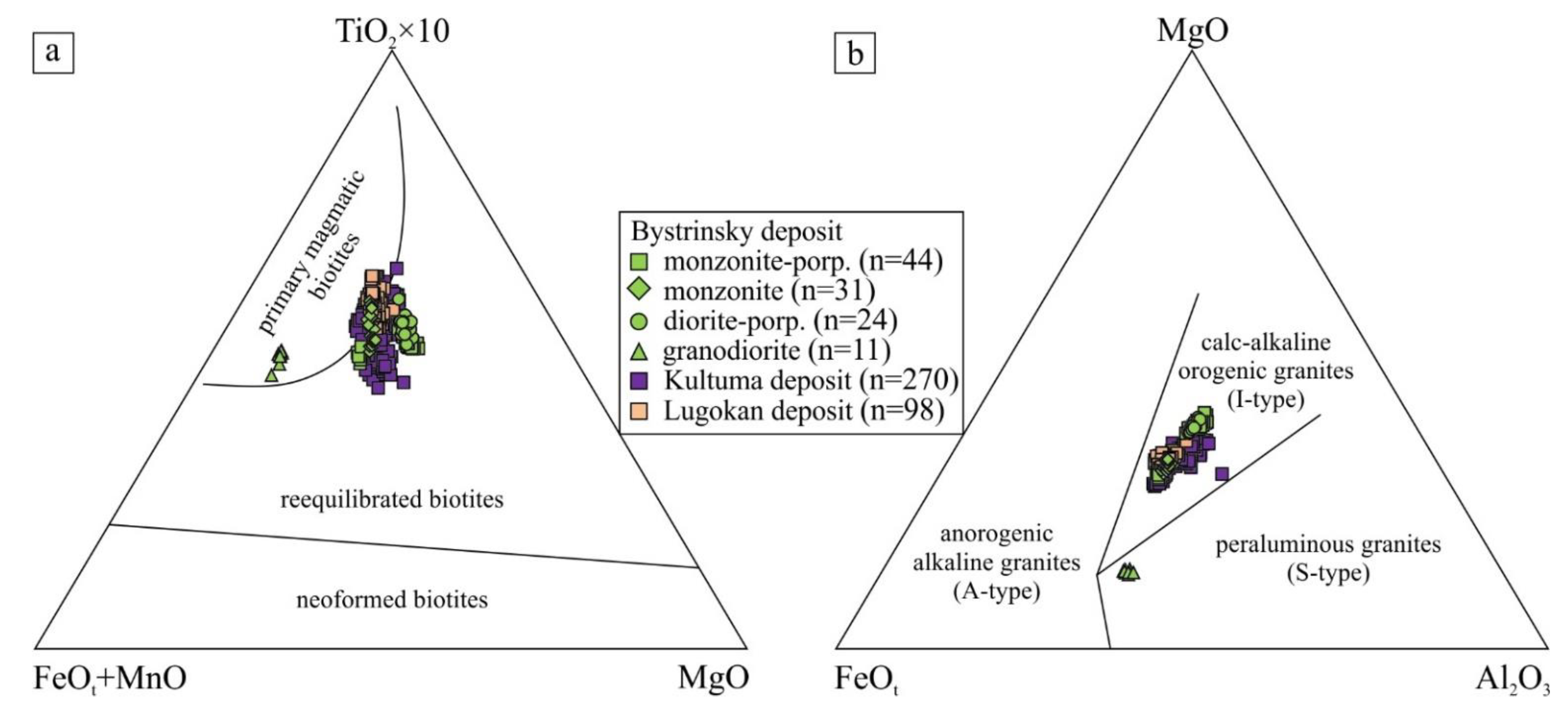


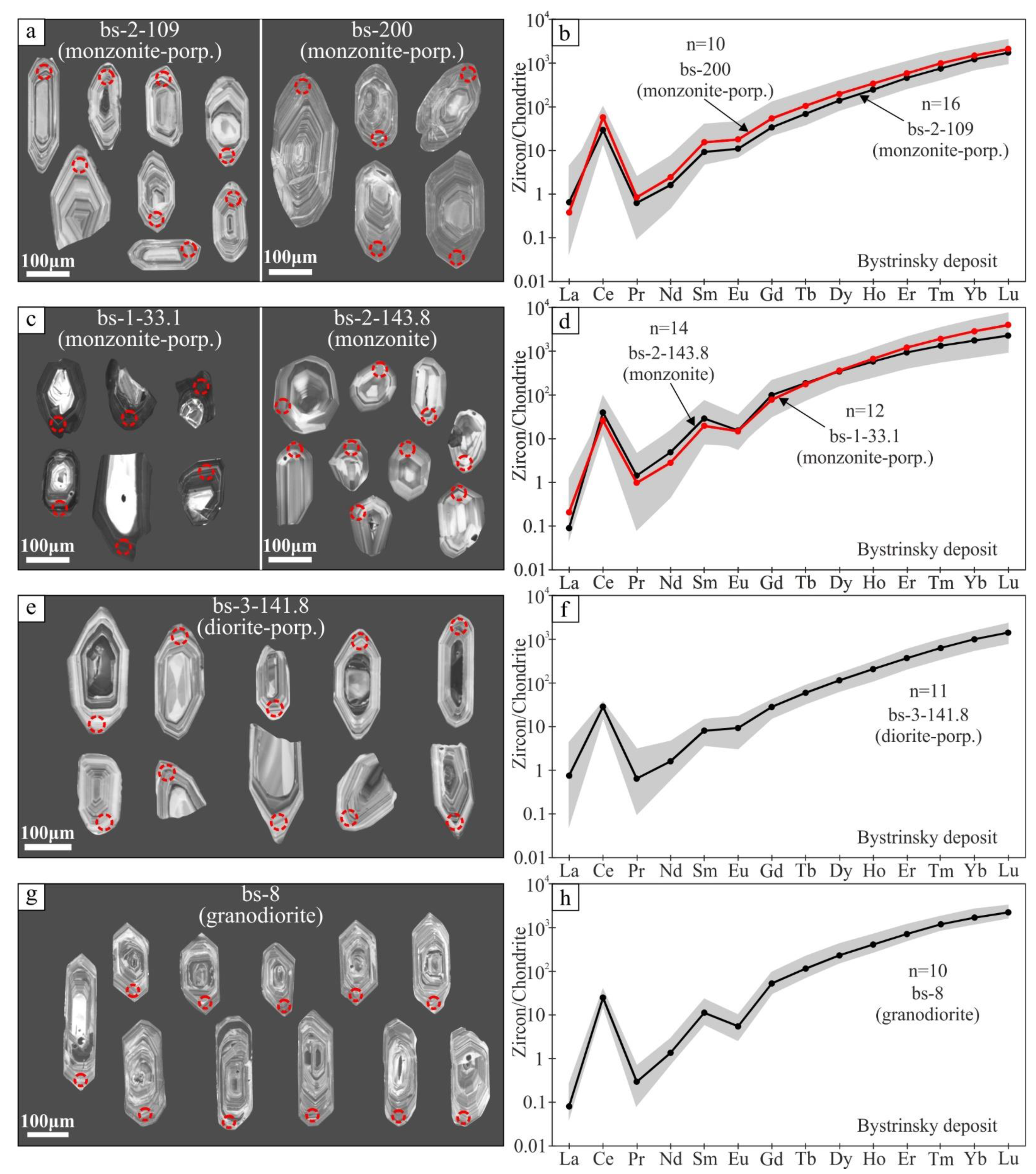
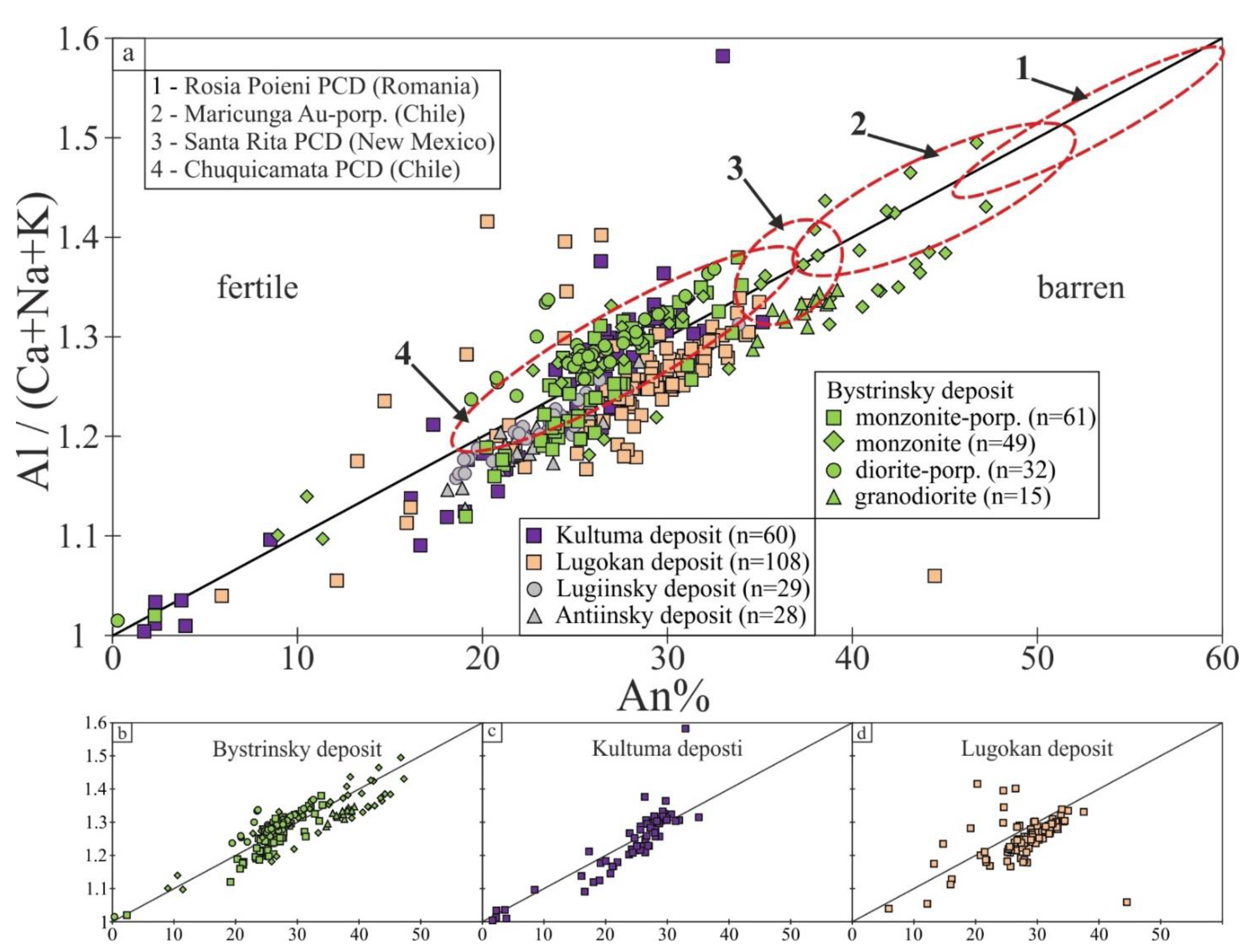

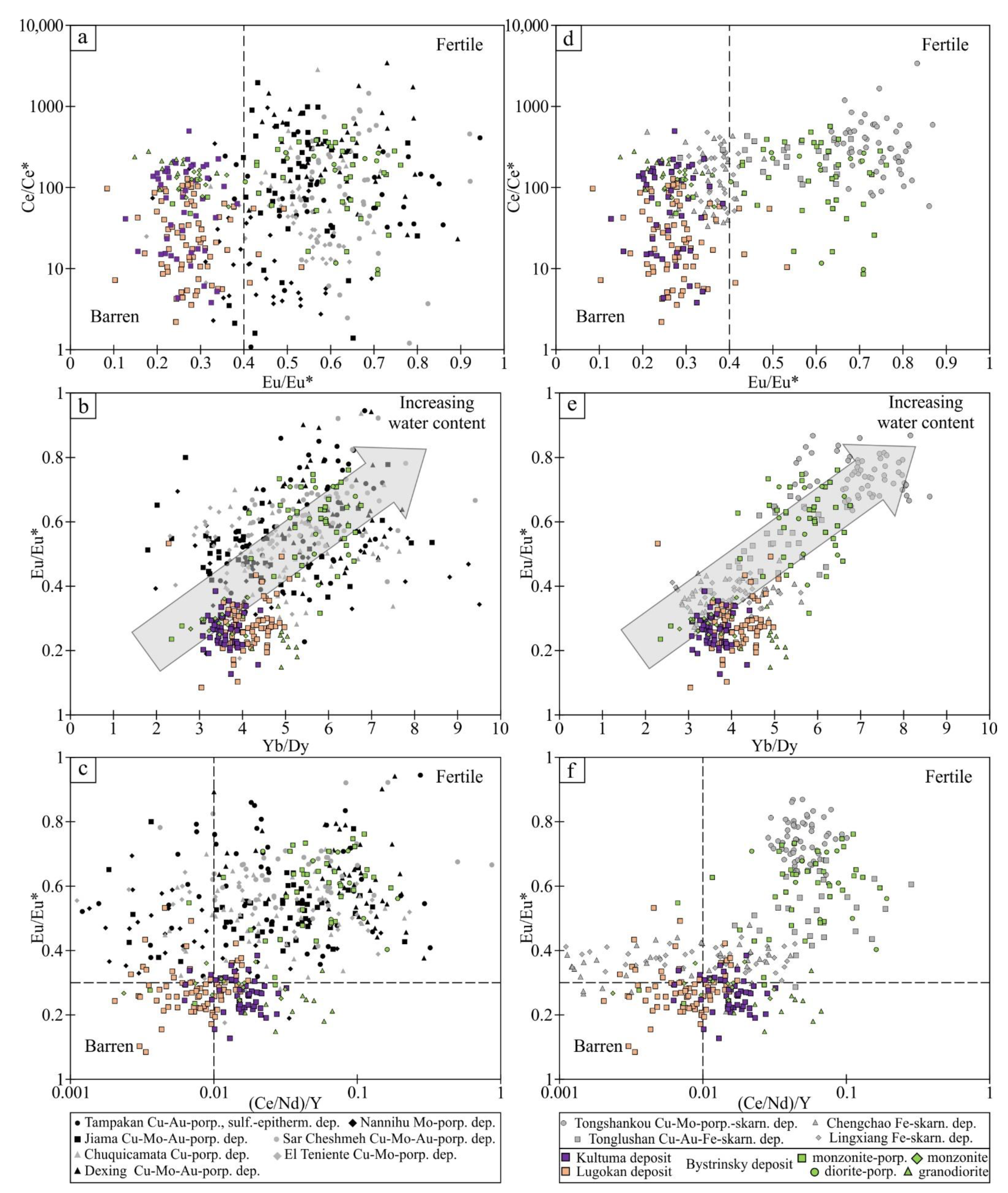
| Deposit | Bystrinsky | Kultuma | Lugokan | ||||
|---|---|---|---|---|---|---|---|
| Rock | Monzonite-Porp. | Monzonite | Diorite-Porp | Granodiorite | Quartz-Monzodiorite-Porp. | Granodiorit-Porp. | |
| mineral | plagioclase | ||||||
| median An% | An26 | An33 | An25 | An37 | An24 | An28 | |
| Al* > 1 (analysis num.) | 27 | 30 | 32 | 0 | 27 | 12 | |
| analysis number | 61 | 49 | 32 | 15 | 60 | 108 | |
| mineral | biotite | ||||||
| IV(F) | min. | 2.18 | 2.12 | 2.16 | 1.61 | 1.48 | 1.72 |
| max. | 2.8 | 2.5 | 2.45 | 1.81 | 2.4 | 2.14 | |
| median | 2.42 | 2.24 | 2.32 | 1.73 | 1.94 | 1.94 | |
| IV(F/Cl) | min. | 4.94 | 6.33 | 6.72 | 5.8 | 4.93 | 5.79 |
| max. | 7.17 | 6.79 | 7.06 | 6.03 | 6.67 | 6.66 | |
| median | 6.56 | 6.5 | 6.87 | 5.9 | 5.98 | 6.16 | |
| log(XMg/XFe) | min. | 0.1 | 0.13 | 0.3 | −0.37 | 0.07 | 0.12 |
| max. | 0.4 | 0.18 | 0.37 | −0.34 | 0.32 | 0.27 | |
| median | 0.29 | 0.16 | 0.33 | −0.36 | 0.22 | 0.17 | |
| log(XF/XOH) | min. | −1.76 | −1.59 | −1.45 | −1.44 | −1.44 | −1.19 |
| max. | −1.2 | −1.26 | −1.12 | −1.25 | −0.55 | −0.8 | |
| median | −1.42 | −1.35 | −1.3 | −1.36 | −1 | −1.02 | |
| analysis number | 44 | 31 | 24 | 11 | 270 | 98 | |
| Deposit | Bystrinsky | Kultuma | Lugokan | ||||
|---|---|---|---|---|---|---|---|
| Rock | Monzonite-Porp. | Monzonite | Diorite-Porp | Granodiorite | Quartz-Monzodiorite-Porp. | Granodiorit-Porp. | |
| Eu/Eu* | min. | 0.21 | 0.25 | 0.4 | 0.15 | 0.13 | 0.08 |
| max. | 0.76 | 0.36 | 0.71 | 0.34 | 0.38 | 0.53 | |
| median | 0.52 | 0.29 | 0.6 | 0.23 | 0.26 | 0.28 | |
| Ce/Ce* | min. | 8.56 | 57.79 | 9.78 | 94 | 3.8 | 2.19 |
| max. | 567.9 | 220.66 | 268.98 | 278.34 | 496.85 | 127.8 | |
| median | 168.84 | 122.75 | 176.59 | 191.65 | 100.14 | 36.8 | |
| (Ce/Nd)/Y | min. | 0.004 | 0.002 | 0.022 | 0.016 | 0.006 | 0.002 |
| max. | 0.172 | 0.031 | 0.191 | 0.067 | 0.032 | 0.021 | |
| median | 0.05 | 0.015 | 0.088 | 0.042 | 0.016 | 0.009 | |
| Yb/Dy | min. | 2.35 | 2.79 | 5.1 | 4.22 | 3.08 | 2.29 |
| max. | 7.84 | 4.12 | 6.62 | 5.27 | 4.42 | 5.09 | |
| median | 5.42 | 3.51 | 5.79 | 4.93 | 3.59 | 4.11 | |
| T(°C) | min. | 554 | 674 | 578 | 675 | 591 | 546 |
| max. | 837 | 765 | 680 | 715 | 808 | 771 | |
| median | 637 | 718 | 639 | 693 | 640 | 645 | |
| total REE (ppm) | min. | 260 | 372 | 206 | 450 | 398 | 346 |
| max. | 1613 | 1198 | 493 | 912 | 954 | 1334 | |
| median | 646 | 709 | 344 | 594 | 639 | 710 | |
| analysis number | 38 | 14 | 11 | 10 | 47 | 74 | |
Publisher’s Note: MDPI stays neutral with regard to jurisdictional claims in published maps and institutional affiliations. |
© 2021 by the authors. Licensee MDPI, Basel, Switzerland. This article is an open access article distributed under the terms and conditions of the Creative Commons Attribution (CC BY) license (https://creativecommons.org/licenses/by/4.0/).
Share and Cite
Redin, Y.O.; Redina, A.A.; Mokrushnikov, V.P.; Malyutina, A.V.; Dultsev, V.F. Rock-Forming (Biotite and Plagioclase) and Accessory (Zircon) Minerals Geochemistry as an Indicator of the Metal Fertility of Magmas by the Example of Au-Cu-Fe-Skarn Deposits in Eastern Transbaikalia. Minerals 2022, 12, 50. https://doi.org/10.3390/min12010050
Redin YO, Redina AA, Mokrushnikov VP, Malyutina AV, Dultsev VF. Rock-Forming (Biotite and Plagioclase) and Accessory (Zircon) Minerals Geochemistry as an Indicator of the Metal Fertility of Magmas by the Example of Au-Cu-Fe-Skarn Deposits in Eastern Transbaikalia. Minerals. 2022; 12(1):50. https://doi.org/10.3390/min12010050
Chicago/Turabian StyleRedin, Yury O., Anna A. Redina, Viktor P. Mokrushnikov, Alexandra V. Malyutina, and Vladislav F. Dultsev. 2022. "Rock-Forming (Biotite and Plagioclase) and Accessory (Zircon) Minerals Geochemistry as an Indicator of the Metal Fertility of Magmas by the Example of Au-Cu-Fe-Skarn Deposits in Eastern Transbaikalia" Minerals 12, no. 1: 50. https://doi.org/10.3390/min12010050
APA StyleRedin, Y. O., Redina, A. A., Mokrushnikov, V. P., Malyutina, A. V., & Dultsev, V. F. (2022). Rock-Forming (Biotite and Plagioclase) and Accessory (Zircon) Minerals Geochemistry as an Indicator of the Metal Fertility of Magmas by the Example of Au-Cu-Fe-Skarn Deposits in Eastern Transbaikalia. Minerals, 12(1), 50. https://doi.org/10.3390/min12010050







